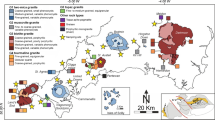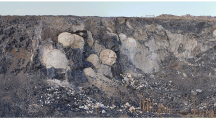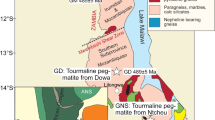Summary
A suite of 29 micas from miarolitic pegmatites associated with granitic units of the anorogenic Pikes Peak batholith (1.08–1.02 Ga), Colorado range in composition, and follow in paragenetic sequence, from 1M siderophyllite (N = 1), and 3T or 2M1 lithian biotite (N = 5) to 1M zinnwaldite (N = 20) and 1M ferroan lepidolite (N = 1). Locally, 1M (?) phlogopite (N = 1) and ferroan 2M1 muscovite (N = 1) are also present. Pervasive, late-stage hydrothermal alteration along with possible supergene weathering of many of these micas produced vermiculite. Additionally, some vugs and cavities were filled with chlorite and/or smectite. Early crystallized micas form tapered columnar crystals in graphic pegmatite, growing toward, and adjacent to the miarolitic cavity zone which contains the later crystallized micas. Principal associated minerals are quartz, microcline perthite (mostly amazonite), and albite, with local topaz or fluorite, and rarely tourmaline (schorl-elbaite).
Progressively younger micas of the main crystallization sequence display increasing Si, Li, F, and Al/Ga, and decreasing total Fe, Mg, and octahedral occupancy. The zinc content of all micas is considerably elevated, whereas Mn, Rb, Cs, and Sc are moderate and T1 is very low. Early siderophyllite and lithian biotite show a narrow range of FeO/Fe2O3 (5.6–8.0), whereas later zinnwaldite is much more variable (2.4–40.3). Annite of the host granite and early graphic pegmatite is compositionally homogeneous, but most mica crystals from cavities show remarkable compositional and abrupt, sharp and distinct color zoning. Most cavity-grown zinnwaldite crystals show a decrease, from core to rim, in total Fe and Mg, whereas Si, Li and F increase and Mn, Rb, Cs and Na are essentially constant. A few to more than 100 color zones have been identified in some mica crystals. The zones are well correlated with the Ti content (<0.2 wt. % TiO2 colorless, 0.4–0.6 wt.% TiO2 red-brown). The total Fe content may or may not correlate with color zoning, whereas Zn variations (up to 1.1 wt. %) are entirely independent. The dark color zones probably reflect Fe-Ti charge transfer.
The mica composition sequence described here is typical of the extreme fractionation observed in pegmatites of the NYF family, associated with anorogenec granites. Elevated Fe, Zn, and enhanced Sc contents are characteristic of this family. Strong enrichment in Li, Rb, and F is present, particularly in the micas of the miarolitic cavities. Sharp color zonation and compositional variation in cavity-grown zinnwaldite and ferroan lepidolite crystals suggest rapid changes in the intensive parameters, particularly the f(O2), of the parent fluid during the final stages of pegmatite consolidation
Zusammenfassung
29 Glimmer aus miarolithischen Pegmatiten, die mit den Graniten des anorogenen Pikes Peak Batholiten (1.08–1.02 Ga) in Colorado vorkommen, schwanken in ihrer Zusammensetzung, und folgen in paragenetischer Abfolge, von 1M Siderophylit (N = 1) und 3T oder 2M1 Lithium Biotit (N = 5) bis zu 1M Zinnwaldit (N = 20) und 1M Eisen-Lepidolit (N = 1). Lokal kommt auch 1M (?) Phlogopit (N = 1) und 2M1 Eisen-Muskovit (N = 1) vor. Anhaltende hydrothermale Umwandlung während später Stadien der granitischen Entwicklung und möglicherweise auch oberflächennahe Verwitterung mancher dieser Glimmer führte zur Entstehung von Vermiculit. Außerdem wurden einzelne Hohlräume mit Chlorit und/oder Smectit gefüllt. Die früh gebildeten Glimmer sind säulige Kristalle in graphischem Pegmatit, die in Richtung auf, und in Nähe der blockigen Zone wachsen; der Groβteil der später gebildeten Glimmer ist in der blockigen Zone und in an diese anschlieβenden miarolithischen Hohlräumen lokalisiert. Die wichtigsten assoziierten Minerale sind Quarz, Mikroklin-Perthit (hauptsächlich Amazonit), sowie Albit, mit lokal etwas Topas oder Fluorit, und selten Turmalin (Schörl-Elbait).
Die Hauptabfolge der Glimmer-Kristallisation zeigt zunehmende Si, Li, F und Al/Ga, aber abnehmende Gesamtwerte für Fe, Mg, und oktaedrische Besetzung. Der Zinkgehalt ist beträchtlich erhöht, während Mn, Rb, Cs, und Sc mittlere und Tl sehr niedrige Werte zeigen. Frühgebildete Siderophylite und Lithium-Biotite zeigen beschränkt Variationen der FeO/Fe2O3 Verhältnisse (5.6–8.0), während späterer Zinnwaldit mehr variabel ist (2.4–40.3). Annit im Wirts-Granit und in frühem graphischen Pegmatit ist seiner Zusammensetzung nach homogen, aber die meisten Glimmerkristalle aus Hohlräumen zeigen bemerkenswerte Zonierung der Zusammensetzung und gut entwickelte Farb-Zonierung. Die meisten in Hohlräumen gewachsenen Zinnwaldit-Kristalle zeigen eine Abnahme an Fe und Mg von Kern zum Rand, während Si, Li, und F zunehmen, sowie Mn, Rb, Cs und Na konstant bleiben. Es können einige wenige, aber auch mehr als 100 Farbzonen entwickelt sein, und diese sind gut mit dem Ti-Gehalt (< 0.2 Gew. % TiO2 farblos, 0.4–0.6 Gew. % TiO2 rot-braun) zu korrelieren. Der Gesamteisengehalt kann, aber muβ nicht mit der Farb-Zonierung korrelierbar sein, während Variationen des Zinkgehaltes (bis zu 1.1 Gew %) vollkommen unabhängig von optischen Aspekten sind. Das Auftreten tieferer Farbtöne dürfte einem Fe-Ti Ladungstransfer zuzuschreiben sein.
Die hier diskutierte Abfolge von Glimmern ist typisch für extreme Fraktionierung in Pegmatiten der NYF Familie, die mit anorogenen Graniten assoziiert sind. Hohe Gehalte von Fe, Zn und erhöhte Sc Gehalte sind charakteristisch. Deutliche Anreicherung an Li, Rb und F ist besonders in den Glimmern aus miarolithischen Hohlräumen festzustellen. Der gut entwickelte optische und chemische Zonenbau in Zinnwaldit und Eisen-Lepidolith Kristallen, die in Hohlräumen gewachsen sind, weist auf intensiven Wechsel der intensiven Parameter der Mineral-bildenden Fuide in den Endstadien der Pegmatit-Bildung hin; dies trifft besonders auf f(O2) zu.
Similar content being viewed by others
References
Bailey SW (1984) Appendix 2-X-ray identification of mica polytypes: In:Bailey SW (ed) Reviews in mineralogy, vol 13. Micas. Mineral Soc of America, 10 pp
Barker F, Wones DR, Sharp WN, Desborough GA (1975) The Pikes Peak Batholith, Colorado Front Range, and a model for the origin of the gabbro-anorthosite-syenite-potassic granite suite. Precam Res 2: 97–160
Blasi A, Brajkovic A, De Pol Blasi C, Foord EE, Martin RF, Zanazzi PF (1984) Structure refinement and genetic aspects of a microcline overgrowth on amazonite from Pikes Peak batholith, Colorado, U.S.A. Bull de Mineral 107: 411–422
Černý P (1991a) Rare-element granitic pegmatites, part I. Anatomy and internal evolution of pegmatite deposits. Geosci Canada 18: 49–67
Černý P (1991b) Rare-element granitic pegmatites, part II. Regional to global environments and petrogenesis. Geosci Canada 18: 68–81
Černý P (1991c) Fertile granites of Precambrian rare-element pegmatite fields: is geochemistry controlled by tectonic setting or source lithologies? Precam Res 51: 429–468
Černý P (1992) Geochemical and petrogenesic features of mineralization in rare-element granitic pegmatites in the light of current research. Appl Geochem 7: 393–416
Černý P, Burt DM (1984) Paragenesis, crystallochemical characteristics, and geochemical evolution of micas in granite pegmatites: In:Bailey S W(ed) Reviews in mineralogy, vol 13. Micas. Mineral Soc of America, pp257–297
Černý P, London D (1983) Crystal chemistry and stability of petalite. Tschermak's Mineral Petrogr Mitt 31: 81–96
Černý P, Stanek J, Novdk M, Baadsgaard H, Rieder M, Ottolini L, Chapman R (1995) Geochemical and structural evolution of micas in the Rožná and Dobrá Voda pegmatites, Czech Republic. Mineral Petrol 55 (this volume)
Clark FW (1887) 4. Iron-mica from near Pike's Peak. Am 7 Sci (third series) 34 200: 136–137
Colby JW (1968) Quantitative microprobe analysis of thin insulating films. Adv X-ray Analyses 11: 287–305
Deer WA, Howie RA, Zussman J (1966) An introduction to the rock-forming minerals. Longman and Sons, New York, 528 pp
De Paolo DJ (1981) Neodymium isotopes in the Colorado Front Range and crust-mantle evolution in the Proterozoic. Nature 291: 193–196
Desborough GA, Luddington SD, Sharp WN (1980) Redskin Granite: a rare-metal-rich Precambrian pluton, Colorado, USA. Mineral Mag 43: 959–966
du Bray EA (1994) Compositions of micas in peraluminous granitoids of the eastern Arabian shield-implications for petrogenesis and tectonic setting of highly evolved, rare-metal enriched granites. Contrib Mineral Petrol 116: 381–397
Dyar MD, Burns RG (1986) Mössbauer spectral study of ferruginous one-layer trioctahedral micas. Am Mineral 71: 955–965
Foord EE, Martin RF (1979) Amazonite from the Pikes Peak Batholith. Mineral Rec 10: 373–384
Foord EE, Starkey HC, Taggart JE (1986) Mineralogy and paragenesis of `Pocket clays' and associated minerals in complex granitic pegmatites, San Diego County, California. Am Mineral 71: 428–439
Foster MD(1960a) Interpretation of the composition of trioctahedral micas. US Geol Survey Prof Paper 354-B, 11–49
Foster MD (1960b) Interpretation of the composition of lithium micas. US Geol Survey Prof Paper 354-E, 115–147
Foster MD, Evans HT (1962) New study of cryophyllite. Am Mineral 47: 344–352
Fratta M (1974) AAS determination of ppb amounts of thallium in silicate rocks. Can Spectroscopy 19: 33–37
Gordiyenko VV, Semenova TF, Simakova YuS (1991) Composition and polytypism of aluminous micas in granitic pegmatites. Mineralogicheski Zhur 12: 67–84 (in Russian)
Gross EB, Heinrich EW (1965) Petrology and mineralogy of the Mount Rosa area, El Paso and Teller Counties, Colorado. I. The granites. Am Mineral 50: 1273–1295
Harada K, Honda M, Nagashima K, Kanisawa S (1976) Masutomilite, manganese analogue of zinnwaldite, with special reference to masutomilite-lepidolite-zinnwaldite series. Mineral J (Japan) 8: 95–109
Harada K, Kanisawa S, Tomita K (1990) Five manganoan zinnwaldites from Japanese pegmatites. Mineral J (Japan) 15: 73–80
Hawley CC, Wobus RA (1977) General geology and petrology of the Precambrian crystalline rocks, Park and Jefferson Counties, Colorado. US Geol Survey Prof Paper 608-B, 77 pp
Hawthorne FC, Černý P (1982) The mica group. In: Černý P (ed) Short course in granitic pegmatites in science and industry. Mineral Assoc Canada 8: 63–98
Henderson CMB, Martin JS, Mason RA (1989) Compositional relations in Li-micas from S.W. England and France: an ion-and electron-microprobe study. Mineral Mag 53: 427–449
Jolliff BL, Papike JJ, Shearer CK (1987) Fractionation trends in mica and tourmaline as indicators of pegmatite internal evolution: Bob Ingersoll pegmatite, Black Hills, South Dakota. Geochim Cosmochim Acta 51: 519–534
Lazarenko EK, Pavlishin VI, Latysh VT, Sorokin YuG (1973) Mineralogy and genesis of the chamber pegmatites of Volynia. Lvov State Univ Publishing House, Lvov, 359 p (in Russian)
Lentz D (1992) Petrogenesis and geochemical composition of biotites in rare-element granitic pegmatites in the southwestern Grenville Province, Canada. Mineral Petrol 46: 239–256
Levillain C, Maurel P, Menil F (1981) Mössbauer studies of synthetic and natural micas on the polylithionite-siderophyllite join. Phys Chem Minerals 7: 71–76
Lewis HC (1880) On siderophyllite - a new mineral. Proc Acad Natural Sci Philadelphia 32: 254–255
Loucks RR (1991) The bound interlayer H2O content of potassic white micas: muscovite hydromuscovite-hydropyrophyllite solutions. Am Mineral 76: 1563–1579
Lowell GR, Tobey EF (1979) Composition of an unusual zinnwaldite from southeastern Missouri. Mineral J 98: 445–459
Menzies MA, Boggs RC (1993) Minerals of the Sawtooth Batholith, Idaho. Mineral Rec 24: 185–202
Monier G, Robert JL (1986) Evolution of the miscibility gap between muscovite and biotite solid solutions with increasing lithium content: an experimental study in the system K2O-Li2O-MgO-FeO-Al2O3-SiO2-H2O-HF at 600°C, 2 kbar PH 2 O: comparison with natural lithium micas. Mineral Mag 50: 641–651
Němec D (1983a) Zinnwaldit in moldanubischen Lithium-Pegmatiten. Chem Erde 42: 197–204
Němec D (1983b) Masutomilite in lithium pegmatites of West-Moravia, Czechoslovakia. N Jb Miner Mh: 537–540
Ponomareva NI, Gordiyenko W (1991) Physico-chemical conditions of formation of lepidolite. Zap Vses Mineral Obshch 120: 31–39 (in Russian)
Ponomareva NI, Gordiyenko W, Butorin W (1993) Physico-chemical conditions of formation of lithium-ferrous iron micas in granitic pegmatites. Zap Vses Mineral Obshch 122: 102–106 (in Russian)
Puffer JH (1972) Iron-bearing minerals as indicators of intensive variables pertaining to granitic rocks from the Pegmatite Points area, Colorado. Am J Sci 272: 273–289
Rancourt DG, Dang MZ, Lalonde AE (1992) Mössbauer spectroscopy of tetrahedral Fe3+ in trioctahedral micas. Am Mineral 77: 34–43
Rieder M (1970) Chemical composition and physical properties of lithium-iron micas from the Krušné hory Mts (Erzgebirge) with chemical analyses byM Huka, D Kučerová, L Minařík, J Obermajer and P Povondra, part A. Chemical composition. Contrib Mineral Petrol 27: 131–158
Rieder M (1971) Stability and physical properties of synthetic lithium-iron micas. Am Mineral 56: 256–280
Robert JL, Volfinger M, Barrandon JN, Batsutcu M (1983) Lithium in the interlayer space of synthetic trioctahedral micas. Chem Geol 40: 337–351
Rossman GR (1984) Spectroscopy of micas. In:Bailey SW (ed) Reviews in mineralogy, vol 13. Min Soc of America, pp 145–181
Schärer U, Allegre CJ (1982) Uranium-lead system in fragments of a single zircon grain. Nature 295: 585–587
Simmons WB, Lee MT, Brewster RH (1987) Geochemistry and evolution of the South Platte granite-pegmatite system, Jefferson County, Colorado. Geochim Cosmochim Acta 51: 455–471
Stone M, Exley CS, George MC (1988) Compositions of trioctahedral micas in the Cornubian batholith. Mineral Mag 52: 175–192
Taylor MC, Foord EE (1993) Clay minerals associated with miarolitic rare-element pegmatites of the peninsular ranges batholith, southern California. Field Trip Guidebook for 30th annual meeting of the Clay Mineral Society, San Diego, CA, 31 pp
Wobus RA, Hutchinson RM (1988) Proterozoic plutons and pegmatites of the Pikes Peak Region, Colorado. In: Holden GS (ed) Geol Soc America Field Trip Guidebook 1988 (Prof Contrib of Colo School of Mines, no 12), pp 35–42
Author information
Authors and Affiliations
Additional information
With 12 Figures
Rights and permissions
About this article
Cite this article
Foord, E.E., Černý, P., Jackson, L.L. et al. Mineralogical and geochemical evolution of micas from miarolitic pegmatites of the anorogenic pikes peak batholith, Colorado. Mineralogy and Petrology 55, 1–26 (1995). https://doi.org/10.1007/BF01162576
Received:
Accepted:
Issue Date:
DOI: https://doi.org/10.1007/BF01162576




